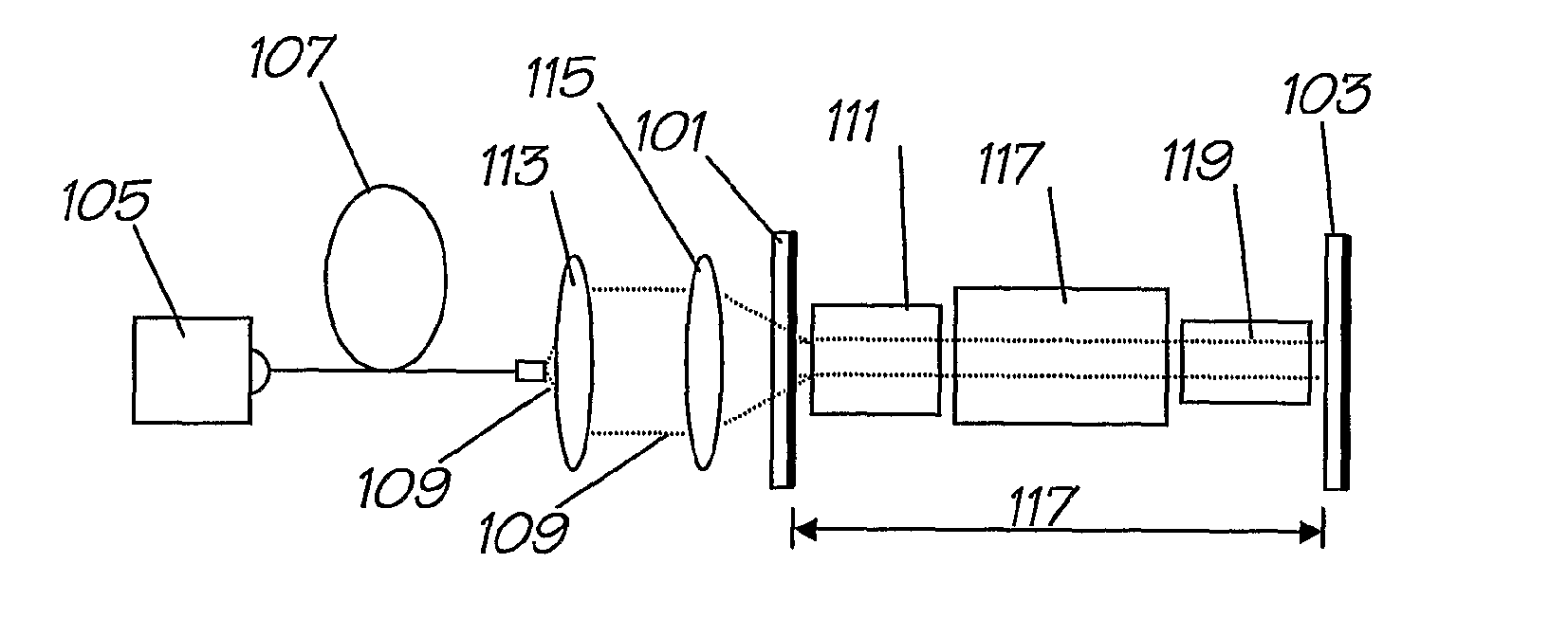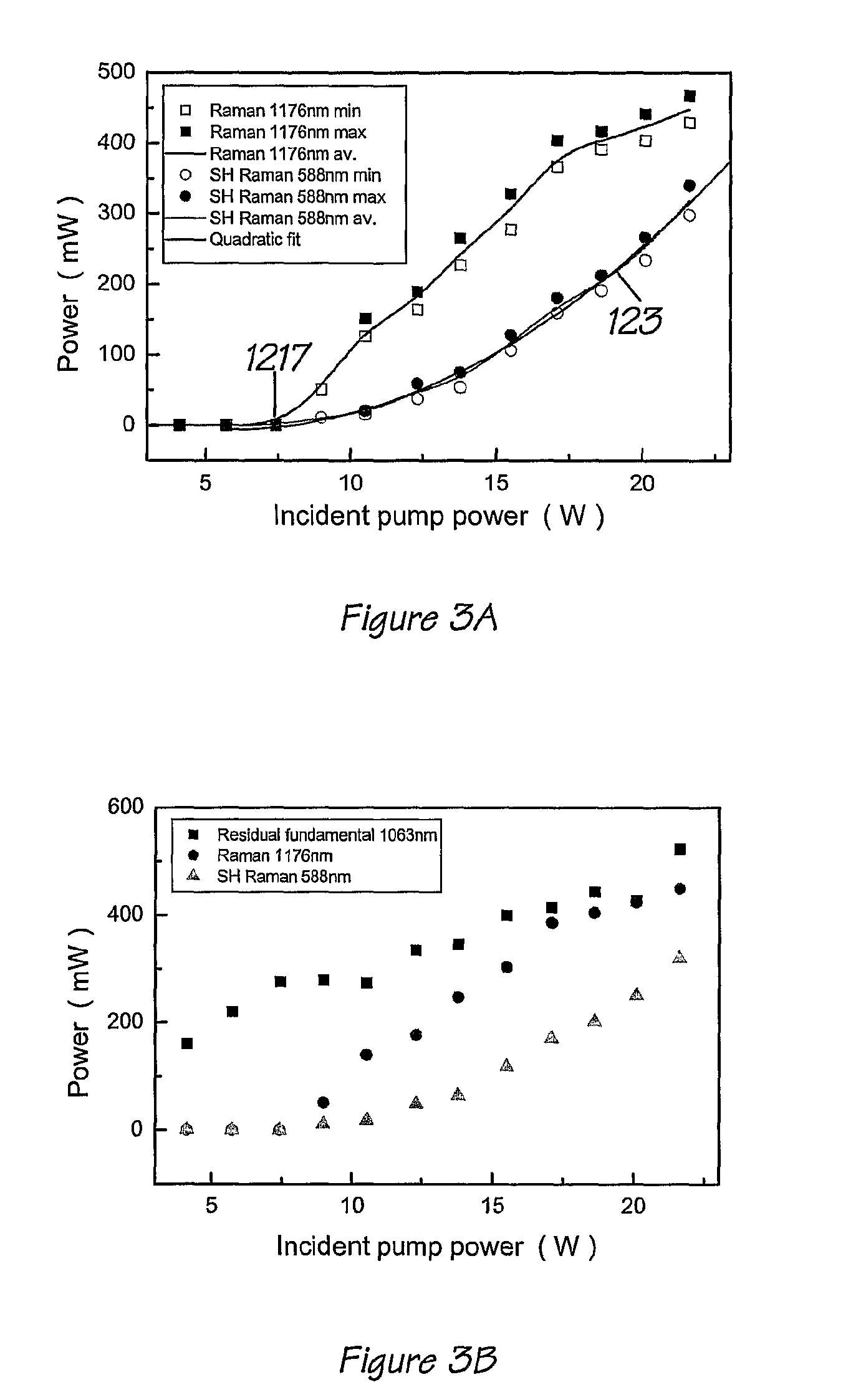Continuous-wave laser
a laser and continuous wave technology, applied in the direction of laser details, basic electric elements, optical resonator shape and construction, etc., can solve the problem that none of these continuous wave raman lasers have incorporated intracavity frequency doubling, and provide any indication on how to achieve such intracavity frequency doubling
- Summary
- Abstract
- Description
- Claims
- Application Information
AI Technical Summary
Benefits of technology
Problems solved by technology
Method used
Image
Examples
example 1
Intracavity-Doubled Continuous Wave Raman Laser
Summary
[0439]Continuous wave operation at 588 nm of a diode-pumped, Raman-shifted (KGW), intracavity-doubled (LBO), Nd:GdVO4 laser is reported. The maximum cw output power at 588 nm was 320 mW when pumped with 18 W from a fibre-coupled diode at 808 nm. An efficient simple, diode end-pumped, intracavity doubled (LBO), Raman-shifted (KGW) Nd:GdVO4 laser is described representing a CW crystalline Raman laser-based yellow source.
Experiment
[0440]A plano-plano resonator showing the arrangement of the laser system of the present example is seen in FIG. 1. The resonator 100 was bound by a flat input mirror 101 2 mm thick, coated 85% T at 808 mm, HR (0.09% T) at 1064 nm, 0.4% T at 1176 nm and with 93% T at 588 nm, and for operation at 588 nm a flat output coupler 103 with the same coating. The pump source 105 was a 30 W fiber-coupled diode laser (φ=400 μm, NA˜0.22) operating at 808 nm with optical fibre 107 for delivery of the pump beam 109. The...
example 2
Intracavity Frequency-Doubled CW Self-Raman Laser
[0458]Intracavity frequency-doubled cw self-Raman laser based on a diode-pumped Nd:GdVO4 / KGW combination has been obtained, with the laser generating 704 mW in the yellow at 588 nm.
[0459]The configuration of the present arrangement of the Raman laser is illustrated in FIG. 6. The pump source 201 was a 30 W fiber-coupled 808 nm diode laser (φ=400 μm, NA˜0.22), imaged with unity magnification through the pump mirror 203 onto an AR-coated (1064-1200 nm) a-cut 0.3 at. % Nd:GdVO4 crystal 205 (3×3×10 mm). Quoted diode pump powers relate to powers incident on the laser crystal 205. Raman shifting was obtained using a KGW crystal 207 with dimensions of 5×5×25 mm, AR-coated for the near-infrared and cut and oriented for propagation along the Np axis with the plane of polarization parallel to Nm. KGW was selected for its superior thermal properties, good Raman gain coefficient and high damage threshold. Second harmonic generation (SHG) of the 1...
example 3
Self-Raman CW Laser
[0479]In this example, intracavity-doubled cw self-Raman laser operation is observed from a laser system based on a diode-pumped Nd:GdVO4 which generates 678 mW in the yellow at 586 m (with a diode-to yellow conversion efficiency of 4.2%) and 2 W cw at the first-Stokes at 1173 nm. Maximum cw powers at both wavelengths were limited by the effects of strong thermal lensing in the laser / Raman crystal. To explore the potential for generating higher cw powers, the laser was operated in quasi-cw mode (50% pump duty-cycle) to reduce the thermal loading of the crystal, whereupon 1.88 W maximum output power at 586 nm was obtained. To the best of the inventors' knowledge this is the first report of cw self-Raman laser operation in Nd:GdVO4 and efficient intracavity doubling of the first-Stokes field to the visible, and the highest output power of any self-Raman laser.
Experimental Set-Up
[0480]The Raman laser configuration is illustrated in FIG. 9. The resonator 300 was bound...
PUM
 Login to View More
Login to View More Abstract
Description
Claims
Application Information
 Login to View More
Login to View More - R&D
- Intellectual Property
- Life Sciences
- Materials
- Tech Scout
- Unparalleled Data Quality
- Higher Quality Content
- 60% Fewer Hallucinations
Browse by: Latest US Patents, China's latest patents, Technical Efficacy Thesaurus, Application Domain, Technology Topic, Popular Technical Reports.
© 2025 PatSnap. All rights reserved.Legal|Privacy policy|Modern Slavery Act Transparency Statement|Sitemap|About US| Contact US: help@patsnap.com



